| |
|
|
The Pictures
on this page will enlarge
when clicked with your mouse |
|
|
Page last updated:
23/05/2021 |
With acknowledgment
to Tony Marshall of Sawbridgeworth |
|
|
A little
bit of history about the Cricket Club |
|
 |
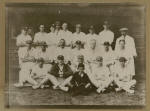 |
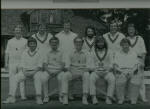 |
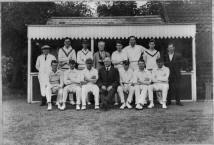 |
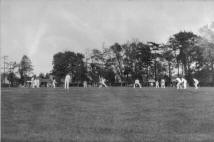 |
This is from
c.1900 when the club played at Pishiobury Park
(behind the modern East Park)
. The club moved back to the present ground of Town Fields the
year after in 1897 (the official founding date of the modern club),
where many games involving the local aristocracy had been played for
years before. The person at the far left on the front row was club
secretary Arthur Morris (*), of 32 Knight Street. This photo was
donated by his grandchildren in 1995.
|
This photograph
is undated, although I would say it looks 1920s (before the pavilion was
built in 1930 anyway). |
This
photograph was taken in 1974, when Sawbridgeworth were a very strong
club, and many of the players had minor county experience. Names as
follows:
Back Row -
Alan Watson, Barry Birch, Ted Levey, David Warne, John Pyle, Henry
Holland.
Front Row - Alan Buck, Terry Dash, Alan Webb (captain), David Abbey,
Tony Cooke
|
Photograph taken in 1929 - probably Whit. Monday - in
front of the old pavilion replaced in 1930 by Sir Walter Lawrence. Team
as follows: Back Row (LtoR) A. Batt (umpire), M.(Marvin?(*))
Everett, Harry Cole, Sir Arthur Cutforth, Ernie Clarke, W.W. Lawrence,
Pat Lawrence, Arthur Clements. Front Row (LtoR) A. Greengrass, F. Prior,
Reg Salmon, Sir Walter Lawrence (Club President), Harry Boatman (Club
Captain), F. Poher, R. Mayfield. |
20th May 1929 (Whit. Monday) the game against Woodford
Green with over 100 spectators visible around the ground. Obviously a
significant village event for the locals on a Bank Holiday. |
(*) See the connection
in
Photo Gallery 1 |
Tony mentions that there
were other players who had connections or were members of the Fire
Brigade. |
| ============================================= =OOO=
============================================== |
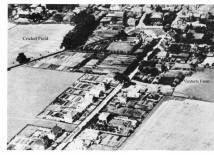 |
Left - A most interesting aerial photograph
of the Southern part of Sawbridgeworth taken in 1929. The Cricket Field
is top left with the newly planted Chestnut Trees only about 8 feet tall
around the perimeter of the field and running down the side of the 'Town
Fields' footpath connecting the Fair Green with Springhall Road On the
very edge of the photograph just above where the name Vantorts Farm is
shown is the Playground of the then National (Church) School that stood
at the top of the hill in Sheering Mill Road - in about 1947 to become
the Secondary Modern School. The large tree in Vantorts Road near the
farm is a Walnut tree and is still standing in 2009. This tree is in the
front garden of the house now built on that land which, when the picture
was taken, was a stack yard to the farm. Right - A close-up enlargement
of Vantorts Farm showing the use of the buildings and area as they were
later in the 1940's 50's. The farm was sold for housing in around 1968. |
| |
 |
| Vantorts Farm |
|
| |
Sawbridgeworth from the air in
1929 |
Quickbury Farm Sawbridgeworth |
| |
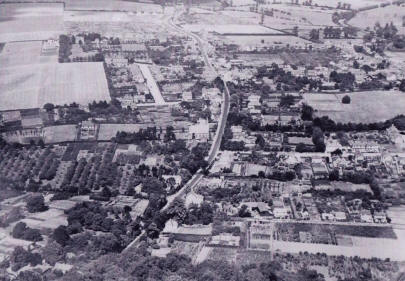 |
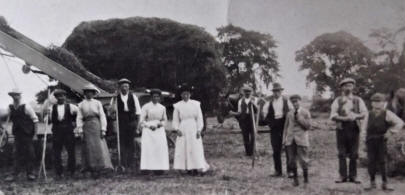 |
| |
In the enlarged photo the Sawbridgeworth Cinema is just
visible on the left and end of Sayesbury Road - the wide one
going South to North.
Photo kindly contributed from research
by Hilary Matthews. |
A charming photograph of
harvest time at Quickbury Farm in 1917. The photo was provided
by Mrs. Josephine Cock whose Grandfather and Grandmother are in
the picture. Mrs. Cock was born, raised and basically educated in Sawbridgeworth but now
lives near Snowdonia in Wales. |
|
|

|
| Other Organisations
- Pictures from the
Webmaster's Library |
| In the early part of the 20th century the thought of
the working classes having holidays from, for most, long working
days from 6am to 6pm and 6 days a week was almost unheard of. By the
time of the mid. 20's though, breaks at weekends (getting a Saturday
off) were becoming more common and for some, they forego their wages
for a week to be able to get away. A very popular Sawbridgeworth
club that met throughout the year was the Young Men's Meeting (YMM)
run by Sidney Parmeter, the Manager of the then grocery store in
Knight Street, Forest Stores. There were annual camps arranged,
mainly at 'local' seaside venues and these were popular and
well attended. As mentioned elsewhere quite a few of those who
attended these camps became volunteer firemen and went through to
serving as Retained members of the Sawbridgeworth Brigade. Below are some records of the camps. (If anyone
can name others in these pictures please advise the Webmaster) |
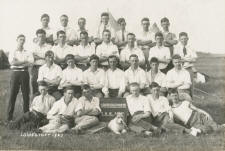 |
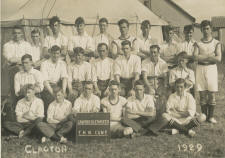 |
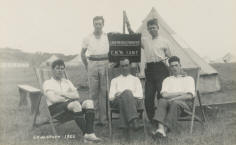 |
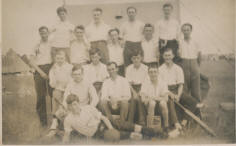 |
| Sidney
Parmeter (Centre - front seated). |
Sidney
Parmeter (Centre - centre row) |
Back: ?, Arthur Bambridge
Front: Frank Wright, Sidney and Sid Morgan |
Little Holland (Essex) 1923 |
| Middle
left 2nd in - Len Rix & Sid Morgan, Front seated second left - Arthur
Bambridge & Frank Wright. Front row 3rd from right Les Brinkworth |
Back row -
5th from right Len Rix, Middle row 2nd from left Frank Wright &
Arthur Bambridge - 3rd from right - Sid Morgan. Front row far right
- Reg. Wright, 4th from right - Jack Searl. |
Back row: left - Arthur Bambridge. Centre row - 2nd
left - Stan Levey. Frank Wright with football. |
 |
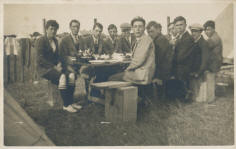 |
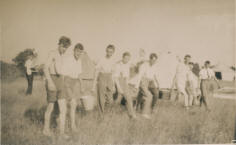 |
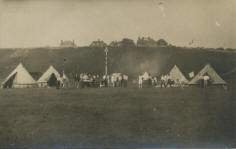 |
| Little
Holland 1922 |
Little Holland 1922 |
Little Holland 1923 |
Lowestoft 1927 |
 |
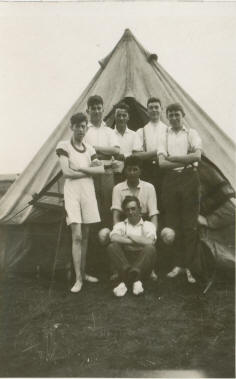 |
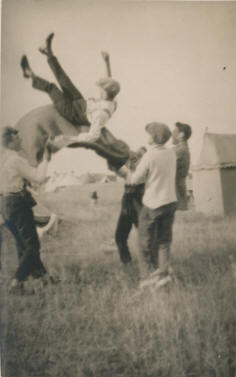 |
 |
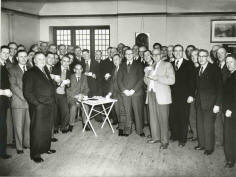 |
|
Lowestoft 1928 |
Lowestoft 1928 |
Little
Holland 1923 |
Old Boys pay tribute |
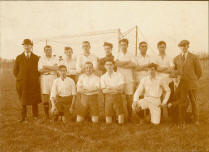 |
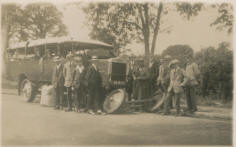 |
| Above
Left: On the
anniversary of Sidney W. Parmeter's 80th birthday those that
had benefitted from the social activities and camps in their
younger days showed their appreciation. With, (left to
right) ? Read, Frank Wright (making the presentation) Ernie Clark, Les Brinkworth, Stan Levey,?,Bill Fish, Bert Russell,
Arthur Bambridge,? Wybrow?,? |
| Above Right: The
full assembly attending the occasion three of whom are
members of the Fire Brigade... Frank Wright, Reg Wright
and Jack Searle. |
. |
|
Sawbridgeworth Football Club c.1925 |
Journeys to and fro camp were not always straight
forward! The Charabanc was not a very comfortable ride at any time
with solid wheels but having no wheels at the front put a stop to
any travel. |
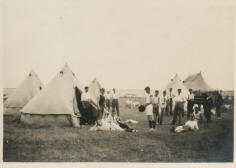 |
 |
| Team members recognisable in the picture are:
Arthur Marshall (next to Bowler Hat);
Fred Harryman (fourth from the
left); Reg Salmon (sixth from left) and Frank
Wright (kneeling right). |
|
|
Lowestoft 1928 |
Little Holland 1924 |
|
|
|
|

|
|
| Sawbridgeworth Industry |
|
Picture with acknowledgment
to John Dear and David Radford of Sawbridgeworth |
| The
picture below is also available for viewing in its full size
|
► |
Full Size
(close-up) |
|
| There are two
pictures available by 'clicking' "Full Size" above
replicating the picture below but with Picture 2 showing
more clearly the extent of the gardens of the then existing
terrace of houses on the Northern side of Sheering Mill Road
(Lane) and also allotments that were accessed from Lower
Sheering Road. Until about 1957 these houses had no flush
toilets or bathrooms - the 'Privy' was in a separate wooden
building at the rear of each house. |
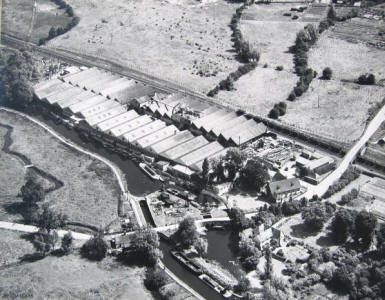 This aerial view of the
Joinery Works is thought to be around 1948. The river Stort is in
the foreground and was still much in use on a commercial
basis with horse drawn barges but mainly with grain to
Burton's Mill in Station Road - about a further ¾ of a mile
to the North. Close inspection of the main Cambridge to
Liverpool Street railway line shows a goods train going
South and it is just possible to make out both the loop line
refuge, between the Station Yard and the Sheering Mill Road
(Lane) bridge, and the Signal adjacent to the bridge that
controlled the loop. The works had its own rail siding that
ran down the centre roadway between the two lines of
buildings. The wood chip cyclone that can be seen on the
roof of the works often caught fire. The works was also a
venue for sizable Fire Brigade exercises involving both
Hertfordshire and Essex brigades - the county boundary is
the little back stream that can be seen and runs behind the
Lock Keeper's bungalow - his well tended garden can be seen
near the bottom of the picture.
The works was a sizeable enterprise and created quite a
hazard (of bicycles) at lunch time 12:30pm and 5:30pm. The
open area towards the road and close to the railway was
the Saw Mill where trees were 'sliced' lengthwise into
planks. These were then stacked with gaps between each plank
- still in the shape of the original tree - to be seasoned,
in the area of where Sun Street now is. The building close
to the road at the works entrance is the Worker's
'Institute', a very popular venue for local dances. The row
of houses now on the North of Sheering Mill Road (Lane) did
not materialise until around the mid fifties. Far right is Luxfords Nursery (Carnation Growers) greenhouses. In the
foreground, adjacent to the arched bridge, is the Mill (House). At
the bottom of the picture in the main river can be seen a steam
dredger and an open barge for the dredged material that was in use
frequently to keep open the navigation between Bishop' Stortford and
the river Lee much nearer London. In the little backwater on the
other side of the arched bridge can be seen the river maintenance
team's boats of which Bill Hurren (a retained member of the fire
brigade) was a member. The field opposite the works with the bridge
over the stream was farmed by Vantorts Farm. It was a rather wet
area in winter and was used mainly for grazing cattle. The
field on the opposite side of the road was rarely used for
anything as it was also wet for long periods. However, on
the far side a small ditch ran into the Lock Keeper's stream
and it was a good source of Water Cress. |
|
| Walter
Lawrence & Sons Joinery Works
Click picture to Enlarge |
|
Picture
below kindly donated by Richard Dyer |
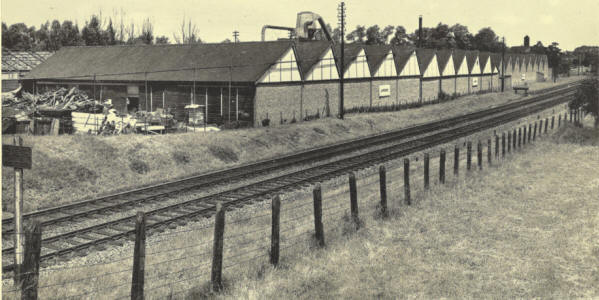 |
Picture (left) from the
Webmaster's
Library
|
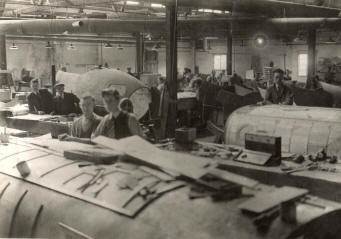 |
| The Joinery Works -
from the Road Bridge |
|
| The fuselage
building section of Walter Lawrence presumably at its peak
production period c. 1943-44. It can be seen that a number of women
were employed in the section. The fuselages themselves were built on plywood jigs which were very
intricate 'moulds' on which the fuselage was assembled. These jigs
were also manufactured on site by specialist Joiners. |
|
|
Above is another view of the Joinery Works
apparently from 1938. The works were badly damaged by an intense bombardment by
German incendiary bombs in the early 1940's which completely gutted the line of
buildings nearest the river Stort. The buildings on that side were
almost entirely of wood construction! This is where the fuselages
for the Mosquito aeroplane were manufactured for deHavilland at
Hatfield. The Saw Yard, where whole trees were processed, is nearest
the camera, The saws
themselves were just inside the building. After the WWII damage the buildings
nearest the river were
fairly quickly rebuilt, this time in brick, and camouflaged - later
to be painted in white. |
More information on this can be found on
the BBC Peoples War Web Site - details are on this site at
the bottom of the page of the link below.
[
The War Years
] |
|

Pictures from the Webmaster's
Library |
 |
After WWII Sir Walter
Lawrence, who lived at Easton Manor Essex, provided a
function for the works staff at his home each year. The photograph
left records those staff that attended on Sunday the 10th August
1952. (The webmaster's maternal Grandfather is 2nd
from the right - middle row) |
|
|
| |
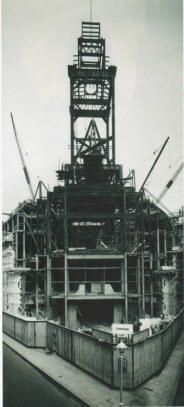 |
Left: The United Grand Lodge of
England
Walter Lawrence & Sons was a substantial
company and very well respected in the building industry. Pre WWII
they were engaged in many prestigious building projects such as
hospitals, large schools, town halls and other public buildings of
merit. Such a project was that of the building of the then new
Masonic Grand Lodge in Great Queen Street, London together with the
Connaught Rooms next door. Here it can be seen under construction in
around 1927/28. Today (), it remains the head quarters of
English Masonry and is also frequently used for period filming. |
There is an interesting connection with
the Masonic Hall in Vantorts Road, situated just South of the King
William IV Public House. Both Sir Walter Lawrence and Bryan Nockolds,
Chief Officer of the Fire Brigade, were members of the
Sawbridgeworth Lodge.
Sawbridgeworth Lodge |
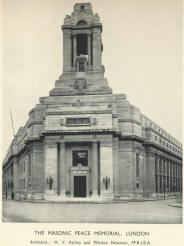 |
This picture of the finished Masonic Hall is thought
to have been taken very soon after completion of the project in the
early to mid. 1930's and is of the main entrance door on the corner
of Great Queen Street and Wild Street. The webmaster's maternal
grandfather worked on the project - see above. |
|

|
| |
|
|

